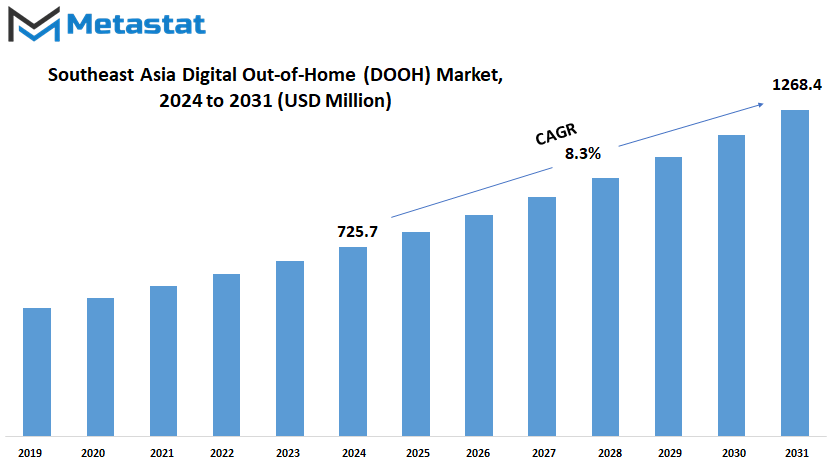MARKET OVERVIEW
In the coming years, the Southeast Asia DOOH market is likely to be a significant chunk of the advertisement industry in the country. It is a place where the convergence of digital technology meets outdoor advertising, forcing a change in the way brands connect with consumers across diverse urban landscapes. Growth in Southeast Asia DOOH will be astonishingly attractive, and in this process, highly innovative and enhanced audience-targeting digital displays will catapult the industry forward.
In the Southeast Asia DOOH market, digital technology will be accepted for the dynamic, interacting ad experience of the future. For instance, it is expected that in most of the busy places like malls, public transport stations, and city centre, digital screens will contain content that could be swapped or even personalized for each viewer in real-time. From this aspect alone, advertising in this Southeast Asia DOOH market would be entirely different from regular and old methods of advertising goods and services. Thus, embracing data analytics and programmatic advertising will help advertisers manage their campaigns much better. Increased urbanization along with an increase in digital connectivity will definitely be a boon to the Southeast Asia Digital Out-of-Home (DOOH) market.
Higher demand to move to urban and rural areas will create a need for innovative advertising solutions hence making the Southeast Asia DOOH market an essential part of the advertising ecosystem. Another factor that will fuel growth in the market is the dominance of the penetration of smartphones and other digital devices facilitating interactive, very engaging content appropriate to tech-savvy high-tech consumers. The Southeast Asia DOOH market would, in the future, be further characterized by technologies including augmented reality and artificial intelligence, among many others. Such technologies will allow an immersive and personalized advertising experience, whereby brands are able to reach greater audiences.
For instance, AR will be able to make digital billboards, which are only static displays of informative content, into a platform that would go through virtual elements of interplays with consumers. Use of AI will instead benefit the targeting capabilities, and now ads become interesting and also related to the watcher's preferred behavior. Sustainability will culminate by being infused into the Southeast Asia DOOH marketplace. Climbing discourses on environmental concerns mean a bigger appeal for environmentally friendly options among advertisers and firms. These phenomena are sure to bring forth energy-efficient digital displays and decrease electronic waste. A concentration on green technologies and practices through innovation with responsibility towards nature is very probable for the Southeast Asia DOOH marketplace. Looking ahead, the Southeast Asia DOOH market will also experience more integration with other digital channels. When synergized perfectly with other digital channels, be it social media or mobile apps, DOOH will perfect the advertisement. Brands will then be able to build integrated campaigns and reach consumers at the point of contact through cross-channel marketing strategies.
Summing it all, the Southeast Asia Digital Out-of-Home (DOOH) market is going to be one of the most significant departments of the communication industry marked by technological innovation and by ever-changing consumer expectations. This Southeast Asia Digital Out-of-Home (DOOH) market will be in supremacy when it comes to the exterior advertising of the region because of their belief in sustainability and cross-channel integration due to delivering experiential interactions with targeted advertising. Future changes in the market would allow brands to understand how to engage with an audience in Southeast Asia.
Southeast Asia Digital Out-of-Home (DOOH) market is estimated to reach $1268.4 Million by 2031; growing at a CAGR of 8.3% from 2024 to 2031.

GROWTH FACTORS
The Southeast Asia Digital Out-of-Home (DOOH) market is promised to be on good trajectory. There are several key factors of influence on this market, and it is necessary to look into what drives its growth and the challenges it faces, in addition to the opportunities ahead.
The first major growth factor is urbanization across Southeast Asia. As cities grow, the more demand for creative advertising can meet the attention of diverse audiences. Digital Out-of-Home is actually an effective way to meet such demand because it provides a more dynamic and flexible medium than traditional forms of advertising. In more detail, an increasing number of urban centers along with density are favorable conditions for DOOH to come into life.
Technological progress also significantly propels the growth of the DOOH market. Artificial intelligence and data analytics incorporated in digital advertisements ensure extremely targeted and personalized content. Such technology makes ads more relevant to viewers, while engagement rates and returns on investment for advertisers rise. In addition, display technology improvement within the display screen and digital billboard promotes market growth as they offer more vibrant and impactful advertising solutions.
Nevertheless, a market has its own set of challenges. Specifically, high initial investments to establish digital infrastructure give a challenge. The cost involved in setting up and maintaining such sophisticated digital displays discour some business firms from entering the market. Regulatory issues and the need for content compliance with local advertising standards stand as barriers in the field. Regulations are usually different across countries in Southeast Asia, making this challenging for companies marketing products in multiple markets.
Despite these headwinds, there is cause for optimism because a string of factors will soon unlock expansive opportunity in the Southeast Asia Digital Out-of-Home market. A good example is the increasing adoption of smart cities initiatives. As cities continue to invest in more smart technologies, DOOH advertising will be interwoven into these systems even further. The growing emphasis on data-driven marketing strategies will also drive DOOH demand, especially among those that provide actionable insights and better targeting capabilities.
In a nutshell, the digital out-of-home market in Southeast Asia will therefore witness huge growth from the rising change in urbanization and technological advents. The challenges here include high initial costs and regulatory hurdles, but the development of smart cities and data marketing offerings has enormous, exciting opportunities awaiting the industry. As things begin to take shape, these same factors will define the future of digital advertising in the region.
MARKET SEGMENTATION
By End-User
Significant changes are bound to sweep through the Southeast Asia digital out-of-home market, of course mirroring the wider shifts in technology and consumers. In 2023, this market was found to have an extensive repertoire of applications across nearly every category, but its footprint differed. The Automotive sector accounted for 21.5% in the DOOH market with $136.5 million in value. That is a pretty big number indicating an increased reliance on digital display to advertise automotive products and services, especially now that the automobile business finds new ways to target an increasingly technologically aware market.
In the Personal Care and Households segment, digital advertising strategies are developing rapidly. This segment’s area of growth lies in the growIng integration of digital displays with ordinary settings to present user-centric promotions for health and wellness products. The Entertainment segment is an example at $115.9 million, demonstrating the growth of the sector into digital channels to communicate with viewers through engaging and interactive messaging.
The Southeast Asia DOOH market is another critical area for retail. Increasingly, shopping experiences are becoming digital and personalized in nature, leading retail players to invest more heavily in digital out-of-home advertising to attract customers into the physical store. In the Food and Beverages segment, the application of digital displays also promotes brand visibility and reaching consumers through dynamic content.
The Telecom sector which is valued at $31.3 million as of 2023 is also growing the DOOH market. With new services and technologies, digital advertising is a significant propeller in the development of the telecom industry. On the other hand, the BFSI segment that accounts for 3.7% of market share, worth $23.5 million, is finding its ground with digital solutions meant for enhancing consumer engagement and sharing real-time information.
Format types in the market: Market’s changing format types are dominated by the billboards, which stood at $258 million in 2023, an evergreen and effective format present in high-traffic areas. Following that comes transit and Street Furniture formats which have a potential for targeted advertising in public space; these formats are supposed to enjoy more investment as they accede to the upwards swelling demand for digital interaction.
The Southeast Asia DOOH market is still growing, and each segment will most likely evolve according to emerging trends and technologies. Sector growth will depend on enough personalized, interactive, and visually appealing content to be able to capture increasingly digital-savvy audiences.
The Southeast Asia Digital Out-of-Home (DOOH) market is not only poised for a dynamic change but also aspiring to become innovative through the evolution and adaptation of new technology advancements as well as shifting consumer behaviors in its way forward. By this segmentation, significant trends and opportunities are revealed for its way forward in the coming years.
One of the growth sectors that stand out in the Southeast Asia DOOH market is the automotive sector. Application within digital advertising becomes more and more sophisticated with quick paces of digital technology advancement, which takes over consumer preferences. The automotive sector is using digital out-of-home advertisements that capture consumers through innovative ways such as interactive screens on dealerships to digital billboards within highways targeting drivers.
The market can be classified into several segments; one such classification is indoor advertising. This indoor part of the Southeast Asia DOOH market accounted for approximately 256.1 USD million in 2023, which sums up to a market share of 40.3%. This high percentage justifies the rising importance of indoor advertising in this particular region. Outdoor DOOH displays are now becoming increasingly common indoors also in areas like malls, airports, and other transit stations with high volumes of traffic. These environments allow advertisers the chance to reach audiences in a far more controlled and targeted way. Because of how digital technology is continually evolving, indoor DOOH solutions will probably be more interactive and personalized, which will enhance the overall effectiveness of an advertising campaign. Outdoor is also an important segment for the Southeast Asia DOOH market.
The outdoor segment makes up a vast set of applications, ranging from digital billboards along highways to interactive displays in urban centers. What appeals about the outdoor DOOH is that it's able to target huge audiences situated in public spaces where it can then capture the attention of passersby. Outdoor advertising will see the high use of technological applications, such as augmented reality technology, and the live display of data. Southeast Asia Digital Out-of-Home is a market poised to enjoy sustainable growth and innovation in the future, as technology evolves with consumer preference. All three segment types-including automotive, indoor, and outdoor-are expected to shape digital advertising in the region. It becomes especially important for advertisers and businesses who wish to tap into the promise of DOOH and become effective at engaging with the target audience.
|
Report Coverage |
Details |
|
Forecast Period |
2024-2031 |
|
Market Size in 2024 |
$725.7 million |
|
Market Size by 2031 |
$1268.4 million |
|
Growth Rate from 2024 to 2031 |
6.5% |
|
Base Year |
2022 |
|
Regions Covered |
North America, Europe, Asia-Pacific Green, South America, Middle East & Africa |
REGIONAL ANALYSIS
Southeast Asia DOOH market is likely to have short-term fabulous growth. Advertising strategies are on the way to something more vibrant and interactive as rapid technological advancement and digital-based solutions lead to more dynamic means of advertising. Besides, lively economy and tech-savvy people in this region offer vast opportunities in the DOOH market. This organic growth of cities in the region to more urbanized, crowed places means that demand for even more innovative advertising is on the rise. Newly accepted are digital billboards, transit advertising, and electronic public displays because of their highly attention-grabbing capabilities and ability to provide instant information.
Growing internet penetration and wider usage of mobile devices are positive factors for the DOOH market in Southeast Asia. These novel digital technologies are used to the maximum level in almost all of the countries across the world, starting with Singapore, Malaysia, Thailand, and Indonesia; hence a suitable base for the DOOH market is available in such countries. Location-based advertisements are reaching a more precise audience than any other form of advertisement; thus it is considered to be the first preference of any advertiser, who wants to reach divergent groups of people within the region.
Another factor has been the rapid growth in Southeast Asia of what may eventually be called smart cities, which contributes to the growth of digital advertising. Government and the local authorities are significantly investing in making the infrastructure with the help of digital screens and displays in their public spaces and transport systems. It gives new opportunities to contact consumers in highly visible locations that give a better effect overall to the campaigns of advertisers.
In the near future, the DOOH Southeast Asia market will soar because businesses will seek even new and innovative ways of connecting with their customers. Thus, the growing presence of data-driven advertisement empowered by AI and machine learning will allow companies to produce meaningful, relevant content for their consumers. Furthermore, the rising trend towards sustainability and environmental consciousness will drive the advertising industry into embracing more digital media platforms that involve less paper usage and less expenditure on energy usage.
The DOOH market is expected to grow steadily in Southeast Asia due to continuing technological improvement, better lifestyles within the urban contours, and connectivity to the region, all of which have a digital edge. This real-time location-based capability for business purposes allows customers to be communicated with in a more interactive manner; hence, this will be an essential component of the future of advertising in Southeast Asia. With the market expanding, there are more inventions that will clearly be shown in how companies interact with their publics in the digital world.

COMPETITIVE PLAYERS
The Southeast Asia Digital Out-of-Home (DOOH) market is expected to grow significantly in the next few years, mainly because it will be fueled by the adoption of digital technologies and innovative strategies in advertising. It is emerging as a critical part of advertising, with many key players defining its future.
Actually, JCDecaux is one of the names better recognized in that market. With extensive networking and cutting-edge digital solutions, JCDecaux boasts a robust presence in urban environments across Southeast Asia. Its strategic investments in technology and infrastructure place it fronts and center in the Digital Out-of-Home (DOOH) advertising space.
Another significant player in the Southeast Asia Digital Out-of-Home market is Clear Channel Outdoor Holdings, Inc. Amongst its commitments to using data-driven insights and state-of-the-art digital displays that "max out" the potency of outdoor advertising campaigns, Clear Channel Outdoor boasts of a singular advantage in the ability to marry digital media to more classic formats in an industry that is very competitive indeed.
Two other leaders in the DOOH market are Dentsu Group Inc. and Hakuhodo DY Holdings Inc. These companies possess great information on marketing and a much better insight into consumer behavior, which they take to the DOOH field. By their unique concepts of digital advertisement, they are able to arm the brands with much better insights into their desired audiences and thus play a significant role in the market's evolution.
Out of Home Media, Big Tree Outdoor Sdn. Bhd. and Mediacorp Pte Ltd have somewhat to our mind represented other prominent firms in that space. Each of the companies is well established in Southeast Asia with a range of digital advertising solutions and activities catering for wide-ranging client needs. Investment in digital technology coupled with an increasing focus on deepening audience engagement mirror the growing importance given to digital out-of-home media within the region.
SEAtronics Inc. and Redberry Sdn. Bhd. both continue to enhance the Southeast Asia DOOH market with their specialty and innovation in solutions. SEAtronics specializes in high-tech digital displays, particularly in high-tech digital displays, while Redberry specializes in more innovative methods of linking digital out-of-home advertising to mobile and social media platforms.
Completing the major players in the region is Plan B Media Public Company Limited, whose creative, impactful digital advertising strategies ensure that the dynamic Southeast Asia DOOH market is always ready for action.
Once those Southeast Asia Digital Out-of-Home markets mature, these players will be at the heart of the future of that industry. Continued investment in technology and innovative approaches will drive growth within the sector, provide new opportunities for the advertisers, and enhance overall effectiveness in out-of-home media within the region.
Southeast Asia Digital Out-of-Home (DOOH) Market Key Segments:
By End-User
- Automotive
- Personal Care and Households
- Entertainment
- Retail
- Food and Beverages
- Telecom
- BFSI
- Others
By Format Type
- Billboard
- Transit
- Street Furniture
- Others
By Application
- Indoor
- Outdoor
Key Southeast Asia Digital Out-of-Home (DOOH) Industry Players
- JCDecaux
- Clear Channel Outdoor Holdings, Inc.
- Dentsu Group Inc.
- Hakuhodo DY Holdings Inc.
- Out of Home Media
- Big Tree Outdoor Sdn. Bhd.
- Mediacorp Pte Ltd.
- SEAtronics Inc.
- Redberry Sdn. Bhd.
- Plan B Media Public Company Limited
WHAT REPORT PROVIDES
- Full in-depth analysis of the parent Industry
- Important changes in market and its dynamics
- Segmentation details of the market
- Former, on-going, and projected market analysis in terms of volume and value
- Assessment of niche industry developments
- Market share analysis
- Key strategies of major players
- Emerging segments and regional growth potential








 US: +1 3023308252
US: +1 3023308252






